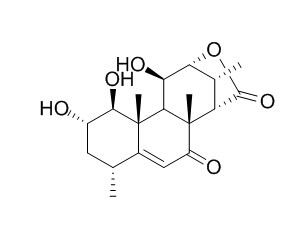Eurycomalide A
Standard reference
Inquire / Order:
manager@chemfaces.com
Technical Inquiries:
service@chemfaces.com
Tel:
+86-27-84237783
Fax:
+86-27-84254680
Address:
1 Building, No. 83, CheCheng Rd., Wuhan Economic and Technological Development Zone, Wuhan, Hubei 430056, PRC
Providing storage is as stated on the product vial and the vial is kept tightly sealed, the product can be stored for up to
24 months(2-8C).
Wherever possible, you should prepare and use solutions on the same day. However, if you need to make up stock solutions in advance, we recommend that you store the solution as aliquots in tightly sealed vials at -20C. Generally, these will be useable for up to two weeks. Before use, and prior to opening the vial we recommend that you allow your product to equilibrate to room temperature for at least 1 hour.
Need more advice on solubility, usage and handling? Please email to: service@chemfaces.com
The packaging of the product may have turned upside down during transportation, resulting in the natural compounds adhering to the neck or cap of the vial. take the vial out of its packaging and gently shake to let the compounds fall to the bottom of the vial. for liquid products, centrifuge at 200-500 RPM to gather the liquid at the bottom of the vial. try to avoid loss or contamination during handling.
Pathogens.2018, 7(3):E62
Univerzita Karlova2021, 20.500.11956.
Phytomedicine.2019, 65:153089
Biochemistry.2018, 57(40):5886-5896
J Nat Prod.2018, 81(4):966-975
BMC Plant Biol.2022, 22(1):128.
Int J Mol Sci.2019, 20(8):E1855
Oncotarget.2016, 8(51):88386-88400
Vietnam Journal of Food Control2022, 5(3):pp.390-401.
Process Biochemistry2019, 85:106-115
Related and Featured Products
Bioorg Med Chem. 2004 Feb 1;12(3):537-44.
Cytotoxic and antimalarial constituents from the roots of Eurycoma longifolia.[Pubmed:
14738962]
METHODS AND RESULTS:
Sixty-five compounds were isolated from the roots of Eurycoma longifolia and characterized by comprehensive analyses of their 1D and 2D NMR, and mass spectral data. Among these isolates, four quassinoid diterpenoids were reported from natural sources for the first time, namely Eurycomalide A (1), eurycomalide B (2), 13beta, 21-dihydroxyeurycomanol (3), and 5alpha, 14beta, 15beta-trihydroxyklaineanone (4). Screening of cytotoxicity, anti-HIV and antimalarial activity of these isolated compounds was also furnished by in vitro assays.
CONCLUSIONS:
Compounds 12, 13, 17, 18, 36, 38, 59, and 62 demonstrated strong cytotoxicity toward human lung cancer (A-549) cell lines, however, 12, 13, 17, 38, 57, 58, and 59 exhibited strong cytoxicity toward human breast cancer (MCF-7) cell lines. Compounds 57 and 58 displayed potent antimalarial activity against the resistant Plasmodium falciparum. The thorough studies on the stereochemistry of the different quassinoid diterpenoids provide a clear reference to the scientists who are interested on this field.



